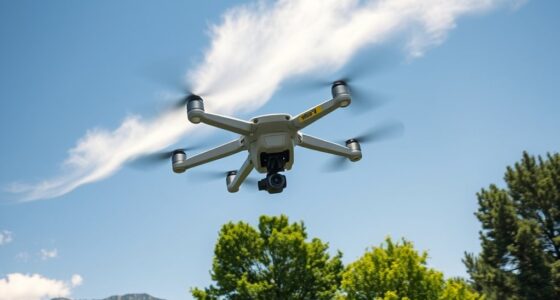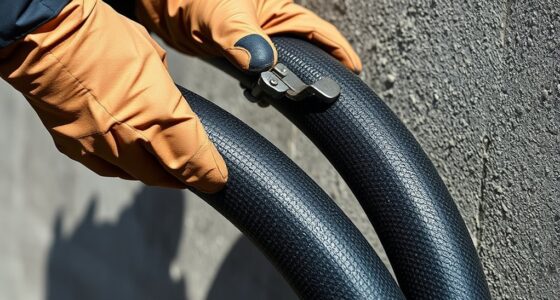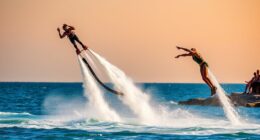As a beginner in flyboarding, you can start mastering spins and dives for an exciting ride. First, get comfortable balancing on the board, keeping your knees slightly bent for stability. Initiate spins by shifting your weight and guiding the handlebars. For dives, crouch down, push off gently, and angle downwards. Always wear your helmet and life vest for safety. Once you feel confident, there’s more to explore to elevate your skills even further.
Key Takeaways
- Always wear safety gear like a helmet and life vest to ensure your safety while practicing spins and dives.
- Start with basic balancing techniques to establish stability on the board before attempting spins and dives.
- Begin spins by gently shifting your weight and guiding the handlebars in the desired direction for better control.
- Practice diving techniques from a crouched position, angling the board downward for a smooth entry into the water.
- Focus on timing and engage your core and legs for stability while performing spins and dives.

If you’re new to flyboarding, you might feel a mix of excitement and apprehension as you hover above the water. The rush of adrenaline is real, and so is the urge to master some beginner tricks. Safety gear is essential, so make sure you’re suited up with a helmet and life vest. These not only protect you but also give you the confidence to explore your new hobby.
New to flyboarding? Embrace the thrill and remember to gear up for safety and confidence!
To start with beginner techniques, it’s vital to become comfortable with the basics of balancing on the board. Practice standing up straight and keeping your knees slightly bent. This position allows you to absorb any sudden movements and helps maintain your balance. Once you feel stable, you can begin to experiment with small spins. To initiate a spin, gently shift your weight to one side while lightly guiding the handlebars in the same direction. It might take a few tries, but you’ll soon find your rhythm.
As you gain confidence, consider adding a few more spins. Instead of just turning in one direction, practice switching it up. This shift not only makes it fun but also enhances your overall control of the board. Remember to keep your legs engaged and your core tight; this will help you maintain stability as you begin to turn faster. Don’t forget to breathe; staying relaxed is key to executing these beginner tricks effectively.
Once you’ve got the spins down, you might be ready to try dives. Diving is a bit more complex but can be incredibly rewarding. Start by lowering your body into a crouched position, then gently push off the water with your feet while maintaining your balance. The goal is to angle your board downward as you dive. Timing is everything here, so practice your approach before attempting a full dive. If you don’t land it perfectly, don’t worry! Remember, every great flyboarder started as a beginner. Additionally, understanding weather conditions can significantly impact your flyboarding experience and safety.
Safety gear is even more essential when learning dives, as you’ll want to protect yourself from any unexpected falls. Don’t hesitate to ask for help or guidance from experienced flyboarders or instructors; they can offer valuable tips and tricks to enhance your skills. With practice, patience, and the right techniques, you’ll soon find yourself mastering spins and dives, enjoying every moment on the water. Flyboarding is all about having fun, so embrace the learning process and enjoy the ride!
Frequently Asked Questions
What Safety Gear Is Needed for Flyboarding?
For flyboarding, you’ll need essential protective gear to guarantee your safety. A well-fitted life jacket is vital, as it keeps you buoyant. Don’t forget a helmet to protect your head from potential falls and a wetsuit to shield your body from cold water and minor abrasions. Always follow safety precautions, like checking your equipment before use and making sure someone’s watching you, so you can enjoy the experience without unnecessary risks.
How Much Does It Cost to Try Flyboarding?
Trying flyboarding typically costs between $100 to $300 for a session, depending on the location and duration. You’ll often find packages that include essential flyboard accessories like helmets and life jackets. To make the most of your experience, remember to check out beginner flyboarding tips, which can help you get comfortable on the board quickly. This way, you’ll enjoy your time while staying safe and having fun!
Is Flyboarding Suitable for All Ages?
Flyboarding’s suitable for a wide range of ages, but there are some age restrictions to take into account. Generally, kids as young as 10 can participate, provided they meet weight and height requirements. However, you’ll need to assess your physical fitness level, as it demands strength and balance. If you’re in good shape and follow the guidelines, you can enjoy this thrilling water sport at almost any age. Just check with your local operator for specific rules!
Can I Learn Flyboarding Without Previous Experience?
Yes, you can learn flyboarding without previous experience! Start with some balance techniques, which are essential for staying upright. Listen to your instructor’s beginner tips—they’ll guide you through the basics. You’ll find that practicing your stance and shifting your weight will help you gain confidence quickly. Just remember, everyone learns at their own pace, so don’t rush it. Enjoy the experience and have fun as you get the hang of it!
What Is the Weight Limit for Flyboarding?
When you first step onto the flyboard, it feels like you’re about to soar like a superhero. Generally, the maximum weight for flyboarding is around 250 pounds, but it can vary by location due to weight restrictions. If you’re close to that limit, don’t worry—many people of different sizes enjoy the thrill. Just remember, staying within the weight guidelines helps guarantee a safe and exhilarating experience as you glide above the water!
Conclusion
In conclusion, mastering beginner tricks in flyboarding opens the door to dazzling displays of daring dynamics. By practicing spins and dives, you’ll not only enhance your skills but also elevate your experience on the water. So, gear up and glide gracefully—each attempt brings you closer to becoming a flyboarding phenomenon. Embrace the exhilaration, and soon you’ll be soaring with style, showcasing stunning stunts that’ll leave spectators spellbound. Happy flying!










